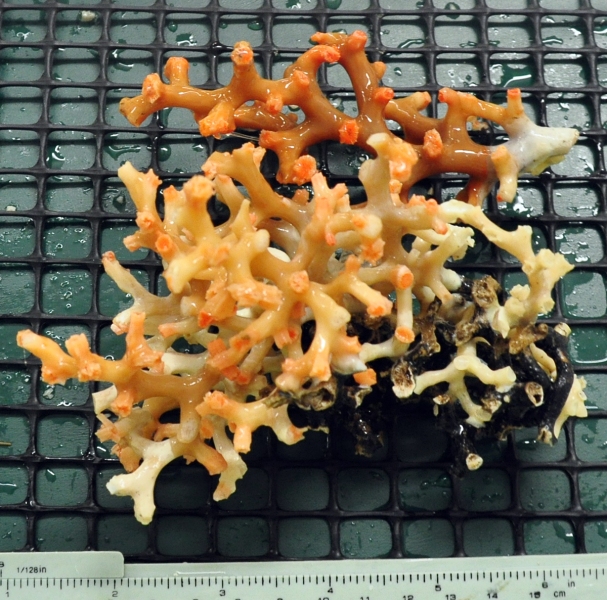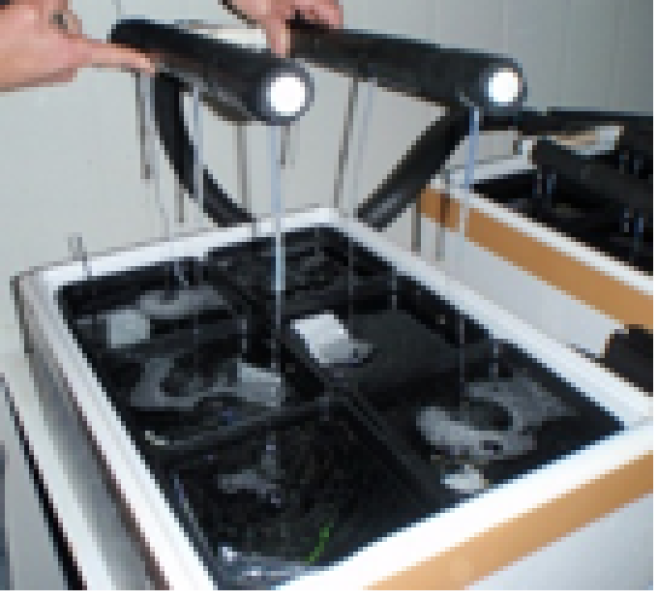Ocean chemistry is changing rapidly due to the influx of carbon dioxide to the atmosphere, largely from human activities including the combustion of fossil fuels. Since the industrial revolution the oceans have experienced a 30% increase in acidity due to this. Atmospheric carbon dioxide is absorbed by the oceans, and a series of chemical reactions occur resulting in lower pH (more acidic) and fewer carbonate ions (the building blocks for calcification). This process has recently been termed 'ocean acidification'.
If current trends continue, the oceans are expected to experience up to a 150% increase in acidity by the year 2100.The rate at which these changes in water chemistry are occurring is unprecedented in Earth’s history, occurring 10 to 100 times faster than any time in the past 50 million years. This is concerning as high carbon dioxide events in Earth’s geologic past have been linked to mass extinction events. Corals (including deep sea corals), shellfish, and some planktonic species that are important food sources for fishes and marine mammals, build their skeletons and shells from calcium carbonate and are especially sensitive to changes in seawater carbonate chemistry. In short, as the acidity of the oceans increase, the ability of many calcifying organisms to build their protective structures becomes more difficult. Many organisms, including VME taxa such as deep-sea corals, may be unable to adapt quickly enough to survive these changes.
The carbonate chemistry of waters surrounding deep-sea coral areas are poorly known globally and to our knowledge has never been measured for the deep-sea coral ecosystems on the Louisville Ridge. On this voyage water samples have been collected throughout the water column at each seamount feature, in particular near the seafloor where deep-sea corals are found. There are several reasons why we are doing this: 1) modeled carbonate chemistry was found to be the most powerful predictor of deep-sea coral habitat in the models we are currently validating via video camera (DTIS) and benthic sampling. Water samples will help refine the accuracy of these models and will be applicable to other SPRFMO areas. 2) We want to determine whether there is any correlation between the health of the deep-sea coral ecosystems we see on video and the carbonate chemistry of the waters surrounding them and 3) carbonate chemistry data from sampled coral areas will aid in our studies on the live deep sea corals collected on this voyage.
Laboratory (in-aquaria) research on deep-sea corals
Very little information exists on the responses of deep-sea corals to increasing levels of carbon dioxide and other environmental changes expected to occur within this century. NIWA conducted a feasibility study in 2011-12 where live specimens of a reef-forming deep-sea scleractinian (stony) coral (Solenosmilia variabilis) were collected and successfully kept alive in aquaria for 14 months, a world first for this species. This achievement proved this species could survive in aquaria over time periods long enough to gain some insight into their tolerance of the high carbon dioxide levels they are likely to experience in the near future. S. variabilis is one of the primary reef-forming coral species in the Southern Hemisphere.
On this voyage we are collecting live scleractinian corals from several seamounts along the Louisville Ridge. We are holding two coral species (S. variabilis and Goniocorella dumosa) in a temperature controlled aquarium system on board Tangaroa. Immediately after collection, all live coral specimens are weighed, labelled, photographed, and then placed into the cold water aquarium (see below). The coral samples are left to settle and recover from the effects of being brought to the surface from the high pressure / low temperature environment they live in at 1 km depth. The aquaria system has a high flow rate (50 L/hr) and temperatures set as close to the temperature found where they were collected (~4 -5oC). Once we return to port the corals will transferred from the ship to NIWA’s ocean acidification facility where the experimental work will take place.
The laboratory experiments will measure the physiological responses of deep-sea corals to increasing levels of carbon dioxide, increasing temperature, oxygen availability, and variable food supply. We expect the tolerances of these two coral species may vary. The results of the water sampling conducted on this voyage will help determine the carbon dioxide treatments used in the manipulative laboratory experiments.


